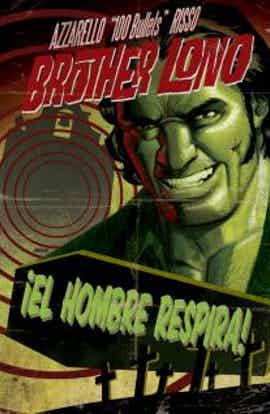
In “100 Bullets: Brother Lono” #1, Brian Azzarello and Eduardo Risso reveal that the larger-than-life, most brutal Minuteman of their epic crime series “100 Bullets” is alive and well, despite being pumped full of lead by Dizzy Cordova. As his own spin-off miniseries begins, Lono lives a quieter life four years later. His new adventure begins with a voiceover, ending with the line “we all die as we were born…gasping for air.”
After this symbolic and fatalistic two-page opener, “100 Bullets: Brother Lono” #1 is all action. Azzarello and Risso immediately introduce a gang, Las Torres Gemelas, whose tattooed leader ups the ante on violence and sadism for “100 Bullets.” There are two graphic torture scenes in this debut issue, and Risso’s stylized line both amplifies and downplays the horror. On one hand, Risso’s aesthetic isn’t gritty, but on the other hand, his composition skills and the starkness of his inks make these scenes even more intense. Similarly, Trish Mulvihill’s warm color palette is beautiful in the opening grave-digging scene, but in the rest of “100 Bullets: Brother Lono” #1, the heat of those golds and reds only reinforces the claustrophobia and the bloodiness of the story’s tone.
Instead of leaving the violence to the reader’s imagination in the panel gutters, the carnage is explicit. While the use of graphic violence achieves its goals of shock and brute-force suspense, it ultimately diminishes “100 Bullets” with its lack of subtlety, and frankly, new readers may be turned off.
Vertigo titles are no stranger to extreme violence, but there has been usually been more originality and justification for it. In “100 Bullets: Brother Lono” #1, Azzarello shakes out a barrel of torture cliches, including (1) removal of eyes and fingers, (2) threatening a child in front of their parent and last but not least, showing a victim that their spouse or lover is being subjected to rape or being sold into prostitution.
Lono doesn’t so much as swat a fly in “100 Bullets: Brother Lono” #1, but Risso reminds readers of what he’s capable of with his hulking posture, muscles and thick facial features. The overarching suspense of the series leans towards the moment when Lono will bust loose with the old ultra-violence. Although Lono was a brutal villain in the original series, he was also a fan-favorite.
Thus, besides its inherent shock and titillation value, all the torture seems to be there to drive home how awful and depraved Lono’s future opponents are, so that no one can possibly mourn Las Torres Gemelas when they inevitably die horribly in the near future. These plot mechanisms are stale. While I hope that Azzarello isn’t going to cheer on retaliatory violence as a heroic response, which seems to be the general direction that the story is going towards. However, the scene sandwiched between the torture indicates a more nuanced approach. Father Manny’s reluctant acceptance of blood money makes him the most morally interesting character so far.
Azzarello and Risso avoid any information dumps with their world-building, and the texture and look of “100 Bullets” still looks fresh. Similarly, the dialogue is quick-moving and distinctive, though like the torture action, it’s a bit much sometimes in content.
“100 Bullets: Brother Lono” #1 is a true return to Azzarello and Risso’s vivid world, intact in texture and mood. Unfortunately, it also it showboats with attention-hungry, sensationalistic violence. Although I appreciate the irony of a debut in which Lono doesn’t do much but wear a Hawaiian shirt and walk around peaceably, the lasting impression of the story is that it has more style than substance.

